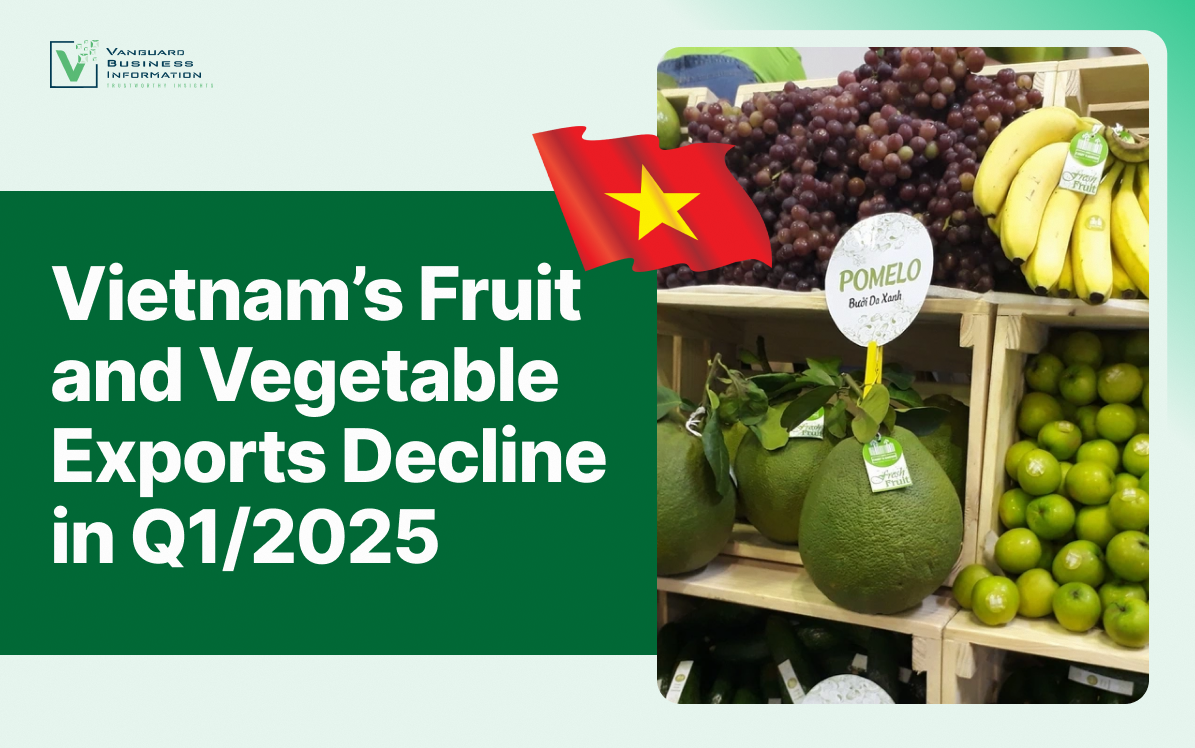Published Apr 2025
Vietnam’s Fruit and Vegetable Exports Decline in Q1/2025
The article “Vietnam’s Fruit and Vegetable Exports Decline in Q1/2025” provides a comprehensive overview of the recent downturn in the country's agricultural export sector. It analyzes the causes behind the decline, including reduced global demand and domestic production issues.

Overview of Export Performance
Vietnam's fruit and vegetable exports experienced a significant decline in the first quarter of 2025. According to preliminary estimates, the export turnover in March 2025 reached USD 421 million, reflecting a 10.5% decrease compared to March 2024. This marks the third consecutive month of decline in the sector.
Cumulatively, exports for the first three months of 2025 are estimated at over USD 1.1 billion, a 13% drop year-on-year.
Data from the General Department of Vietnam Customs shows that in February 2025, exports stood at USD 313.97 million, down 16.2% from January 2025 and 3.6% from February 2024. For the first two months, total export turnover reached USD 686.9 million, reflecting a 15.7% year-on-year decline.
Key Factors Behind the Decline
The primary reason for the export slump is a significant decrease in durian exports—a key product that accounted for nearly 50% of the sector's total export value in 2024. The sharp drop was largely driven by stricter quarantine and food safety regulations imposed by major importing countries, particularly China.
China has implemented more rigorous inspections for Basic Yellow 2 (BY2) and cadmium in Vietnamese durians. This has led to congestion at warehouses and border checkpoints, disrupting the flow of exports. Other fruits like jackfruit and dragon fruit have also come under tighter scrutiny for chemical residues.
Beyond China, a number of other export markets have also raised their standards. Since January 8, 2025, the European Union doubled its inspection rate for Vietnamese durians from 10% to 20%. Markets like the United States, South Korea, Japan, Australia, and New Zealand have also imposed strict requirements regarding pesticide residue, heavy metals, and sustainability standards, including labor and environmental practices.
Increased competition from countries with strong fruit and vegetable sectors is further pressuring Vietnam's exports.
Policy Recommendations and Industry Response
If regulatory barriers are not promptly addressed, Vietnam’s goal of achieving USD 8 billion in fruit and vegetable exports in 2025 will be challenging.
To reach this target, producers and exporters must:
- Strictly comply with updated inspection and safety regulations.
- Strengthen supply chain linkages to improve product quality.
- Invest in processing, packaging, and design to meet international standards.
On the regulatory side, the Ministry of Natural Resources and Environment has urged exporters to:
- Avoid using banned substances and ensure that residue levels stay within the permissible limits of importing countries.
- Implement comprehensive food safety controls at orchards, farming zones, and at all processing, packing, and storage facilities to ensure smoother export processes in the near future.
Export Market Performance
The structure of Vietnam’s fruit and vegetable export markets shifted in early 2025. Exports to China, UAE, the Netherlands, and Russia dropped, while shipments to other markets like the U.S., Japan, and Malaysia rose significantly.
Vietnam’s Fruit and Vegetable Export Markets – February and First Two Months of 2025
|
Market |
Feb 2025 (USD '000) |
vs Jan 2025 (%) |
vs Feb 2024 (%) |
2M 2025 (USD '000) |
vs 2M 2024 (%) |
Share 2M 2025 (%) |
Share 2M 2024 (%) |
|
Total |
313,972 |
-16.2 |
-3.6 |
686,899 |
-15.7 |
100.00 |
100.00 |
|
China |
132,963 |
-23.6 |
-32.0 |
305,771 |
-38.9 |
44.51 |
61.41 |
|
USA |
34,448 |
10.2 |
101.1 |
65,621 |
65.5 |
9.55 |
4.86 |
|
South Korea |
22,397 |
19.8 |
16.4 |
41,098 |
0.1 |
5.98 |
5.03 |
|
Japan |
17,012 |
4.4 |
66.3 |
33,311 |
22.9 |
4.85 |
3.33 |
|
Thailand |
11,465 |
-42.1 |
16.4 |
31,273 |
9.1 |
4.55 |
3.52 |
|
Australia |
7,955 |
-11.4 |
26.9 |
16,971 |
11.0 |
2.47 |
1.88 |
|
Taiwan |
8,133 |
26.2 |
97.5 |
14,575 |
9.4 |
2.12 |
1.63 |
|
UAE |
5,414 |
-33.6 |
-8.1 |
13,562 |
-4.8 |
1.97 |
1.75 |
|
Malaysia |
6,498 |
26.1 |
58.1 |
11,647 |
35.4 |
1.70 |
1.06 |
|
Netherlands |
5,293 |
-8.0 |
-30.9 |
11,059 |
-28.2 |
1.61 |
1.89 |
Top 20 Exporting Companies – January–February 2025
Vietnam’s fruit and vegetable export sector is led by both multinational companies and domestic enterprises. Below is a list of the 20 largest exporters based on turnover during the first two months of 2025:
Top 20 Fruit & Vegetable Exporting Enterprises
|
No. |
Company Name |
2M 2025 Export Value (USD '000) |
|
1 |
18,197 |
|
|
2 |
16,652 |
|
|
3 |
14,574 |
|
|
4 |
13,707 |
|
|
5 |
12,148 |
|
|
6 |
10,754 |
|
|
7 |
10,072 |
|
|
8 |
8,962 |
|
|
9 |
8,569 |
|
|
10 |
8,258 |
|
|
11 |
7,013 |
|
|
12 |
6,621 |
|
|
13 |
6,574 |
|
|
14 |
6,443 |
|
|
15 |
6,345 |















